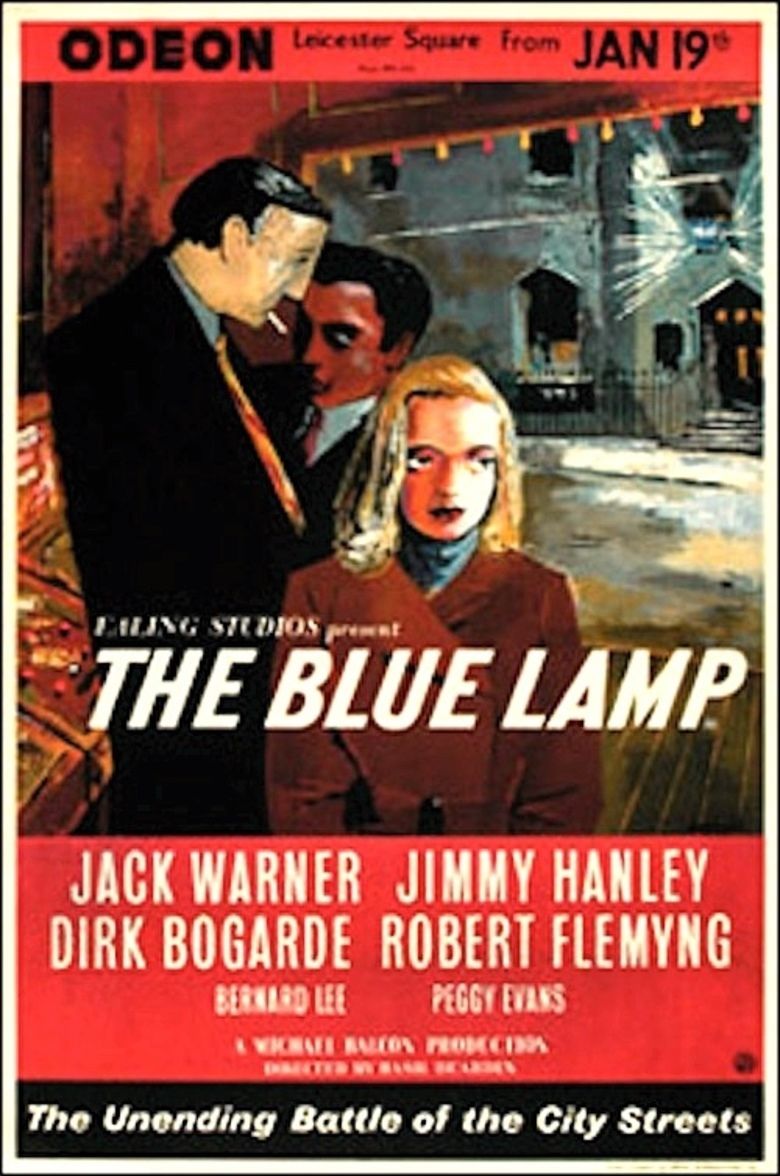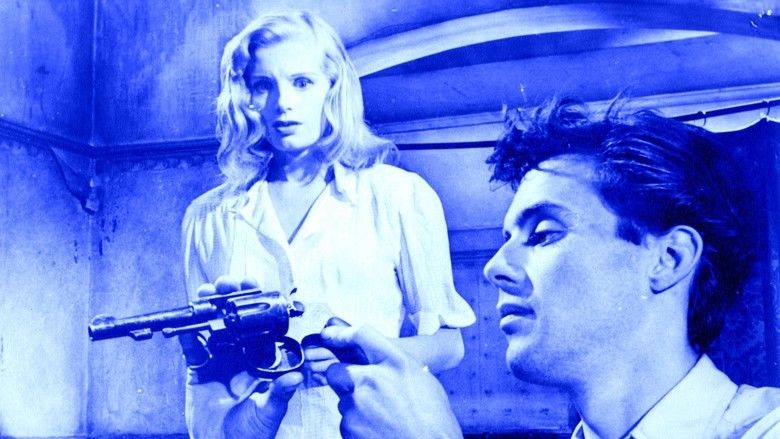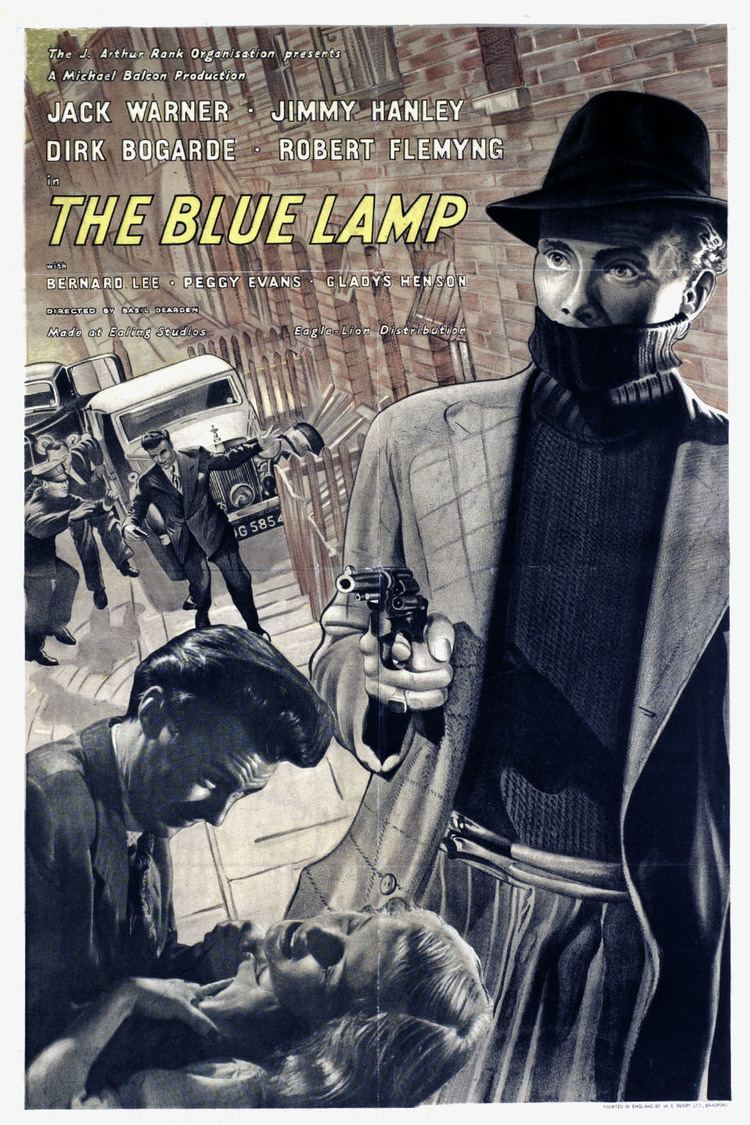The Blue Lamp
7 /10 1 Votes
Screenplay T. E. B. Clarke Country United Kingdom | 7/10 IMDb Genre Crime, Drama, Thriller Duration Language English | |||||||||||||||||||||||||||||||||
 | ||||||||||||||||||||||||||||||||||
Release date 20 January 1950 (1950-01-20) (UK) Writer T.E.B. Clarke (screenplay), Jan Read (original treatment), Ted Willis (original treatment), Alexander Mackendrick (additional dialogue) Cast (PC George Dixon), (PC Andy Mitchell), (Tom Riley), (Police Sgt. Roberts), (Inspector Cherry), (Diana Lewis) Similar movies Street Wars , True Justice Blood Alley , Angel of Death , True Justice 2: One Shot, One Life , Dead Drop , Urban Warfare Tagline Sheds just enough light for MURDER | ||||||||||||||||||||||||||||||||||
The blue lamp intro jack warner
The Blue Lamp is a 1950 British police drama, directed by Basil Dearden and starring Jack Warner as veteran PC Dixon, Jimmy Hanley as newcomer PC Mitchell, and Dirk Bogarde as hardened criminal Tom Riley. The title refers to the blue lamps that traditionally hung outside British police stations (and often still do). The film became the inspiration for the 1955–1976 TV series Dixon of Dock Green, where Jack Warner continued to play PC Dixon until he was 80 years old (even though Dixon's murder is the central plot of the original film).
Contents
- The blue lamp intro jack warner
- The blue lamp george gets shooted mpg
- Plot
- Production
- Locations used
- Reception
- Awards
- Legacy
- References

The screenplay was written by ex-policeman T. E. B. Clarke. The film is an early example of the "social realism" films that emerged later in the 1950s and 1960s, but it follows a simple moral structure in which the police are the honest guardians of a decent society, battling the disorganised crime of a few unruly youths.

The blue lamp george gets shooted mpg
Plot

The action mostly takes place in the Paddington area of London, and is set in July 1949, a few years after the end of the Second World War. PC George Dixon (Warner) a long-serving traditional "copper" who is due to retire shortly, takes a new recruit, Andy Mitchell (Hanley), under his aegis, introducing him to the easy-going night beat. Dixon is a classic Ealing "ordinary" hero, but also anachronistic, unprepared and unable to answer the violence of Tom Riley (Bogarde). Called to the scene of a robbery at a local cinema, Dixon finds himself face-to-face with Riley, a desperate youth armed with a revolver. Dixon initially tries to talk Riley into surrendering the weapon, but Riley panics and fires. Dixon is taken to hospital, but dies some hours later. The ending is another Ealing quirk, with ordinary, decent society banding together with professional criminals and dog-track identities to track down and catch the murderer, who tries to hide in the crowd at White City greyhound track in West London. To Andy Mitchell falls the honour of arresting Riley.
Production
The production had the full co-operation of the Metropolitan Police, and the crew were thus able to use the real-life former Paddington Green Police Station, then at 64 Harrow Road, London W9 and New Scotland Yard for location work. Most of the other outdoor scenes were filmed in inner west London, principally the Harrow Road precincts between Paddington and Westbourne Park. George Dixon is named after producer Michael Balcon's former school in Birmingham.
Locations used
The original blue lamp was transferred to the new Paddington Green Police Station. It is still outside the front of the station and was restored in the early 21st century. Most of the locations around the police station are unrecognisable now due to building of the Marylebone flyover. The police station at 325 Harrow Road, not far from the site of the Coliseum Cinema (324–326 Harrow Road), which is also shown in the film, has a reproduction blue lamp at its entrance.
The Metropolitan Theatre of Varieties, featured prominently at the start of the film, was demolished because it was thought likely that the Marylebone flyover would need the site, although that turned out not to be the case. It is now the site of Paddington Green Police Station. The scene involving a robbery on a jeweller's shop was filmed at the nearby branch of national chain, F. Hinds (then at 290 Edgware Road). This was also knocked down when the flyover was built.
The scenes of the cinema robbery were filmed at the Coliseum Cinema on Harrow Road, next to the Grand Union Canal bridge. The cinema was probably built in 1922, was closed in 1956 and later demolished. The site is now occupied by an office of Paddington Churches Housing Association.
Some of the streets used, or seen, in the film include: Harrow Road W2 and W9, Bishop's Bridge Road W2, Westbourne Terrace Bridge Road W9, Delamere Terrace, Blomfield Road, Formosa Street, Lord Hill's Road, Kinnaird Street and Senior Street W2, Ladbroke Grove W10, Portobello Road W11, Latimer Road, Sterne Street W12 and Hythe Road NW10. The church which features prominently towards the end is St Mary Magdelene Church, Senior Street W2. All of the streets around the church were demolished in the 1960s to make way for the new Warwick Estate in Little Venice. Tom Riley's home was in the run-down street of Amberley Mews, north of the canal, and is now the site of Ellwood Court, part of the Amberley Estate. It is from this mews that Riley walks into Formosa Street, then crosses the Halfpenny Bridge. He then goes into Diana Lewis's flat on the corner of Delamere Terrace and Lord Hill's Road where he attacks her and is chased out by the following detective. Then follows one of the first extended car chases in British film. The route of the chase is as follows: Senior Street W2, Clarendon Crescent W2, Harrow Road W9, Ladbroke Grove W10, Portobello Road W11, Ladbroke Grove W10, Royal Crescent W10, Portland Road W10, Penzance Place W10, Freston Road W10, Hythe Road NW10, Sterne Street W12 – then a chase on foot into Wood Lane and then to White City Stadium. Most of the chase is a logical following of Riley's car apart from when the car goes from Hythe Road NW10 into Sterne Street – Hythe Road in 1949 was a dead end.
Reception
The Blue Lamp premiered on 20 January 1950 at the Odeon Leicester Square in London, and the reviewer for The Times found the depiction of the police work very plausible and realistic, and praised the performances of Dirk Bogarde and Peggy Evans, but found Jack Warner's and Jimmy Hanley's two policemen portrayed in a too traditional way: "There is an indefinable feel of the theatrical backcloth behind their words and actions ... The sense that the policemen they are acting are not policemen as they really are, but policemen as an indulgent tradition has chosen to think they are, will not be banished."
In the context of a campaign against perceived "middle-class complacency" in British film-making, Sight & Sound editor Gavin Lambert (writing under a pseudonym) attacked the film's "specious brand of mediocrity" and suggested the film was "boring and parochial", views which caused outrage and were not reflected by the record public patronage.
The film had the highest audiences in Britain for a British film that year.
Awards
The film won the 1951 BAFTA Award for Best British Film and was nominated for the Golden Lion at the 1950 Venice Film Festival.
Legacy
In 1951 a stage play of the same name was written by Willis and Read. It ran for 32 performances at the Hippodrome in London. In 1952 the play ran for 192 performances in a summer season at the Grand Theatre, Blackpool, Lancashire. Gordon Harker took the role of George Dixon, while Jack Warner played Chief Inspector Cherry.
Several of the characters and actors were carried over into the TV series Dixon of Dock Green, including the resurrected Dixon, still played by Warner. The series ran on BBC One for twenty-one years from 1955 to 1976, with Warner being over eighty by the time of its conclusion.
In 1988, Arthur Ellis's satirical BBC Two play The Black and Blue Lamp had the film characters of Riley (Sean Chapman) PC "Taffy" Hughes (Karl Johnson) transported forwards in time into an episode of The Filth, a gritty contemporary police television series, replacing their modern-day counterparts.
The League of Extraordinary Gentlemen: Black Dossier by Alan Moore and Kevin O'Neill has one panel suggesting George Dixon died in August 1898, the time-period given for the first two graphic novels, as well as The War of the Worlds. However, no explanation of this claim is given. Here is one: the real George Dixon (1820–98) was the Victorian politician after whom Balcon's school was named.
In 2010, the BBC Television drama Ashes to Ashes concluded with a short clip of George Dixon, referring to the similarity to Dixon's death in The Blue Lamp and subsequent resurrection for the television series and the underlying plot of the show.
References
The Blue Lamp WikipediaThe Blue Lamp IMDbThe Blue Lamp themoviedb.org
